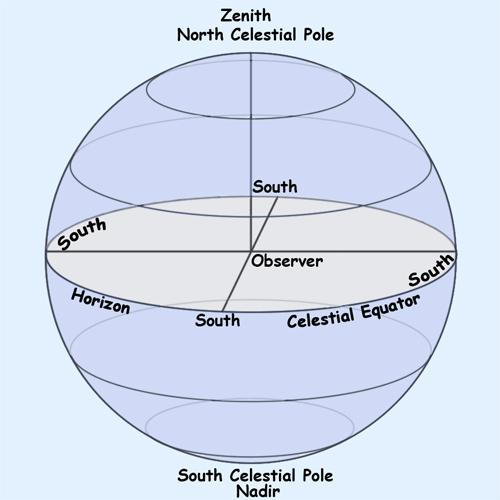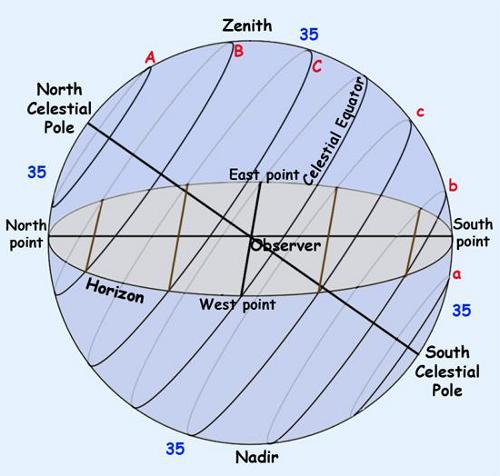|
The Altitude of the Pole
Relationship between latitude and the altitude of the Pole; discussion, and diagram. Brief discussion of how this leads to different motions at different latitudes, leading into detail discussion with diagrams.
The Motion of the Sky at the Poles

Rotation of the Sky at the North Pole
The stars move parallel to each other and the Celestial Equator. Since the Celestial Equator is on the Horizon, each star has constant altitude. No star rises or sets; all stars are circumpolar. Every direction on the Horizon is South, and the stars move to the right or West while the Earth moves under them, to the East. At the South Pole every direction on the Horizon is North, and the stars move to the left or West while the Earth moves under them, to the East. In other words the Earth moves to the East and the stars to the West regardless of where you are and what direction you are looking; but your position and viewpoint can alter the apparent direction relative to you.
The Motion of the Sky at the Equator

Rotation of the Sky at the Equator The stars move parallel to each other and the Celestial Equator. Since the Poles are on the Horizon, the Equator rises vertically at the East point and sets vertically at the West point. All stars rise vertically in the East and set vertically in the West (see the Equatorial view of the sky in Kenya, below). All the paths of the stars are cut in half by the horizon, so all stars are up half the time and down half the time, regardless of their position. No star is circumpolar, no matter how close it is to the Celestial Pole.

(click on the picture for a larger version) Above: A panoramic view of stars setting on the western horizon, as seen at the Equator in Kenya. On the left stars circle clockwise around the South Celestial Pole, rising on the left (which is east when facing south) and setting on the right (which is west when facing south). On the right stars circle counterclockwise around the North Celestial Pole, rising on the right (which is east when facing north) and setting on the left (which is west when facing north). Everywhere, the stars set at right angles to the horizon (the horizontal white line), as they all move parallel to the Celestial Equator, which crosses the Horizon at right angles at the Equator. (LeRoy Zimmerman, apod021115)
The Motion of the Sky at Mid-Latitudes

Rotation of the Sky at 35 Degrees North Latitude The stars move parallel to each other and the Celestial Equator. The North Celestial Pole is 35 degrees above the North point on the horizon. The South Celestial Pole is 35 degrees below the South point on the horizon. The Celestial Equator rises at the East point at a 35 degree angle to the vertical, crosses the Meridian (the North-South line through the Zenith) 35 degrees south of the Zenith and sets at the West point, at a 35 degree angle to the vertical. Half the Celestial Equator is above the Horizon and half is below it, so stars on the Celestial Equator are up half the time, and down half the time, just as at the Equator (where all stars are up half the time, and down half the time). Stars following path 'A' are always up, even though they get higher and lower, because they are closer to the North Celestial Pole than it is to the Horizon. Stars following path 'a' are always down, even though they get higher and lower, because they are closer to the South Celestial Pole than it is to the Horizon. Stars following paths 'B' and 'C' are up more than half the time, while stars following paths 'b' and 'c' are down more than half the time. The closer a star is to the Celestial Equator the more nearly it is up half the time and down half the time; the closer it is to a Pole, the more nearly it is always up or always down. Whatever angle a star rises North or South of East, it sets at that same angle North or South of West.
Summary
ON EVERY PLANET:
The altitude of the Celestial Pole (its height above the horizon) is the same as your latitude. Therefore, at the poles of the planet the Celestial Pole is overhead; at the Equator it is on the horizon; and at mid-latitudes it is at an angle to the horizon.
At the Pole(s) the paths of the stars are horizontal, never getting any higher or lower (for a given star), so that if a star is up it is always up, and if it is down it is always down.
Half the sky is always up.
Half the sky is always down.
At the Equator the paths of the stars are vertical, are cut exactly in half by the ‘horizon’, and since the motions of the stars are ‘uniform’, each and every star is up half the time and down half the time. Every star is up half the ‘day’ (24-hr on the Earth), and down half the ‘day’.
All of the sky is up half the time.
At mid-latitudes (such as where we live), things are more complicated. Some stars are always up and others always down (similar to the situation at the Poles), some are up and down half the time (similar to the situation at the Equator), and others are up more than half the time but not all the time, and others are down more than half the time but not all the time.
For every part of the sky where stars are up more than half the time, there is a symmetrical part where the stars are up less than half the time, so that on the average half of the sky is up at any given time (which should go without saying :-) ).
|